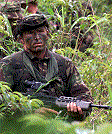Operation Barras

On August 25th 2000, a patrol of 11 men from the 1st Royal Irish Regiment was captured by the notorious 'West Side Boys' while on patrol in Sierra Leone. Five of the British soldiers were released on Sunday 3rd September, after negotiations. However, negotiations for the remainder of the soldiers became stagnated and fears for their safety increased. The hostages were being been held at the militia's jungle base in Okra Hills, about 70 kilometres (50 miles) east of the capital.
It had become obvious to the Government that the freeing of the six British soldiers of the Royal Irish Regiment, taken hostage by Sierra Leone rebels, had reached a stalemate and after many days of negotiations the MOD decided to mount a rescue mission.

The 1st Battalion of the Parachute Regiment was alerted and a small force of about 150 men was detailed to the rescue mission. The Paras were flown to neighbouring Senegal, and were moved quietly into Freetown itself. Helicopters for the air assault were flown into the capital hidden in giant Hercules transports, and Chinooks, stationed in Senegal, were to be flown to Sierra Leone at the last possible moment . The hostages had been tracked to the camps by an SAS reconnaissance tea; having found the hostages their mission was to stay near and gather intelligence about enemy numbers and weaponry and passing the information back by satellite phone.
The SAS confirmed that the rebel gang had high-powered machine guns situated on the south side of the river, as well as the camp at Geri Bana, and across the 300 yards of Rokel Creek two more villages provided bases for the rebels. The Paras would have to make a two pronged attack. It was decided that the attack would go in at dawn on Sunday the 10th of September. The flight to the targets would only take about 15 minutes and the raid was spearheaded by two Lynx attack helicopters. The army choppers, bristling with machine guns, came in low at 200 kph and were over the camps before the rebels had properly woken up. They flew in two waves, with one flying up the mouth of the river to attack from the north while the other flew across the jungle to come upon the camps from the south.

The pilots, flying at tree-top height, picked their way through mangrove swamps and mud flats at the edge of the river to put their aircraft down as close as possible to the villages. The rescue team, armed with SA80 rifles, heavy machine guns and 81mm mortars, scrambled out of the helicopters into the half-darkness, clutching rifles and machine guns, and weighed down with stripped-down mortars the Paras ran across the scrub towards the huts. As the Paras' helicopters roared overhead, the SAS recon team stormed the huts and secured the hostages. The lightly armed Special Forces troops knew they could only hold the location for a short time before being overwhelmed and their assault had to be timed to perfection. Within 20 minutes the six captives and a Sierra Leonean Army liaison officer, seized with them, were airborne bundled into a helicopter and heading to the safety of the RFA LSL Sir Percival, anchored off Freetown.
By now the rebels were fully awake and turned their considerable fire power on the Paras. In the initial attack many of the rebels fled into the jungle. Once there they regrouped and launched a counter attack. The heavy machine guns stationed across the river also opened up on the British forces. The Paras scrambled for cover among the huts, fired back and quickly assembled their mortars. Soon the distinctive crump of the 81mm mortar rounds landing into the tree line mingled with the crackle of high velocity rifle fire and the deeper thump of the machine guns. It had taken just 90 minutes to subdue the rebel gang, and as the Paras flew out, dangling beneath each Chinook was one of the Land Rovers driven by the Royal Irish Regiment when they were taken hostage. The vehicles had been captured intact.
The mission in the mangrove swamps of Rokel Creek took just 90 minutes but the fire fight left one of the rescuers dead, one seriously wounded and another 11 wounded. 25 of the rebel forces, three of them women, were also killed and a further 18 including their leader 'Brigadier' Foday Kallay were captured.



